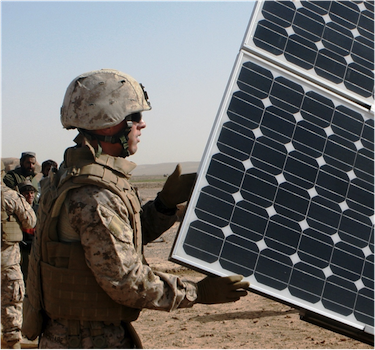
Co-written by Sierra Club Senior International Attorney Steve Herz

Photo courtesy of Stewart Boss, Climate Progress
Last week, President Obama made it crystal clear that his administration "will respond to the threat of climate change, knowing that the failure to do so would betray our children and future generations." But he also made clear taking action is much more than an obligation to posterity, it is also an issue of American leadership: "The path towards sustainable energy sources will be long and sometimes difficult. But America cannot resist this transition; we must lead it." Now, with Sen. Kerry's nomination for secretary of state, President Obama has a unique opportunity to make good on this rhetoric by leading a solar surge.
Solar power has undergone a historic transition from expensive niche technology to a rapidly expanding cheap technology that is experiencing dramatic growth rates. The best part is that the technology is ideally suited for many developing countries making it an integral part of any U.S. international clean energy strategy. Whether it's reducing peak power deficits, replacing costly diesel, or providing energy access to the rural poor solar power can deliver. As fossil fuel energy costs soar, and solar's benefits are more widely understood, it is placed to grow dramatically. But to truly take advantage of this historic opportunity the U.S. administration needs to lead a solar surge and no one is better placed than Secretary Kerry.
A solar surge requires four tactical moves that, taken together, would constitute big change: 1) Leverage cheap Export Import Bank (Ex-Im) Bank finance to spur solar development in emerging markets 2) Expand Overseas Private Investment Corporation's (OPIC) renewable energy portfolio with a focus on increasing its off grid solar lending 3) Work with the IFC to establish a $500 million solar PV funding facility for emerging markets and 4) Push the World Bank to establish a $500 million off grid clean energy access fund. This may seem like a laundry list of asks but most of these pieces are already moving. All that is needed is leadership -- just like the kind President Obama offered on Monday.
So here's how Secretary Kerry builds off Obama's leadership. The first step is to work with OPIC and Ex-Im Bank (the two agencies that contribute the majority of U.S. climate finance) to dramatically increase solar lending in emerging markets. Right now it's a tale of two agencies -- OPIC is a clean energy champion and Ex-Im is a basket case. With Ex-Im's cheap finance to catalyze deployment, and struggling domestic U.S. solar manufacturers seeking new markets, this should be an obvious way to support and expand on previous stimulus package investments.
The next step is to take on the World Bank. The U.S. is one of the largest financial contributors to this institution and much like President Obama, the Bank's president Dr. Kim has made clear his desire to lead on climate change. Secretary Kerry can take advantage of this opportunity to work with him to establish a $500 million funding facility that will catalyze distributed solar investment in emerging markets by offering public funds that will leverage private capital. Think third-party finance for rooftop solar in the U.S., but in countries with hundreds of millions of roofs. Given how competitive solar is today this should have already happened. Working with Dr. Kim to establish this fund is an easy win for Kerry and the administration.
The final step will be the toughest but most crucial. Solar and other distributed clean energy technologies are the only way the vast majority of the rural poor will ever receive power -- at least according to the International Energy Agency (IEA). The World Bank has already helped Bangladesh install 1 million solar home systems so it's clear they can do this. But they also refused a call from the world's leading social entrepreneurs for a $500 million off grid clean energy access fund at the recent Rio+20 conference. The Bank says energy access and sustainability are a priority. Secretary Kerry needs to help them put their money where their mouth is.
These relatively simple steps will put concrete actions behind President Obama's words and set the tone for Secretary Kerry's tenure. A tone defined by his embrace of clean energy and his conviction to take on climate change. Establishing this credibility will be critical because his much larger climate fight -- eliminating coal and other international fossil fuel financing -- looms large. Starting with a solar surge will rally the troops to his side and set the stage for the State Department to move from climate villain to climate hero and once and for all silence those who question the reality behind the rhetoric.
